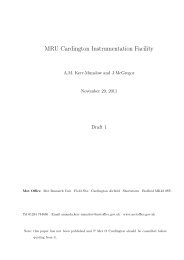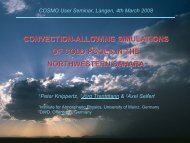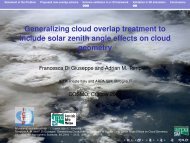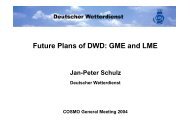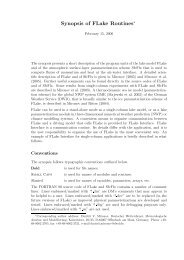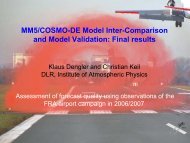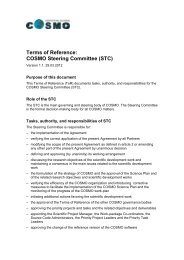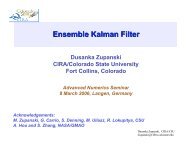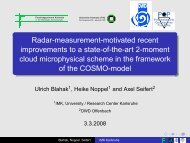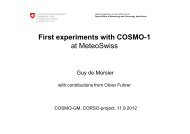document - Cosmo
document - Cosmo
document - Cosmo
Create successful ePaper yourself
Turn your PDF publications into a flip-book with our unique Google optimized e-Paper software.
1 Working Group on Data Assimilation 3<br />
Tomographic Determination of the Spatial Distribution of Water Vapor<br />
Using GPS Observations<br />
M. Troller 1 , A. Geiger 1 , E. Brockmann 2 , J.-M. Bettems 3 , B. Bürki 1 ,<br />
H.-G. Kahle 1<br />
1 Institute of Geodesy and Photogrammetry, Swiss Federal Institute of Technology, Zürich,<br />
Switzerland<br />
2 Swiss Federal Office of Topography, Geodetic bases and permanent networks, Wabern, Switzerland<br />
3 Federal Office of Meteorology and Climatology, Zürich, Switzerland<br />
1 Introduction<br />
GPS meteorology is a promising technique to estimate the total amount of water vapor in the<br />
troposphere on a continuous basis using satellite navigation systems, (e.g. Bevis et. al., 1992).<br />
With GPS tomography, it is aimed at determining also the vertical distribution of water vapor<br />
in the troposphere with a high temporal resolution (e.g. Flores et. al., 2000; Hirahara, 2000;<br />
Kruse, 2001; Troller, 2004). In this study, hourly resolution has been investigated, which<br />
represents a major improvement compared to time resolution obtained from operational<br />
ballon soundings.<br />
2 Principle of GPS Tomography<br />
GPS signals are significantly influenced by the atmosphere, especially the ionosphere and<br />
troposphere, along their path from the satellite to the GPS antenna. The satellites are<br />
transmitting at two different carrier frequencies in the radio L-band. As the ionosphere is a<br />
dispersive medium in the radio frequency range, its influence can be eliminated by composing<br />
a linear combination of the two GPS carrier frequencies. The remaining effect is caused by<br />
the delay of the signal due to the refractivity of the troposphere. Furthermore, this effect<br />
can be subdivided into a so-called dry and wet part, the latter being proportional to the<br />
integrated precipitable water vapor (e.g. Hofmann-Wellenhof et. al., 2001).<br />
The main advantages of GPS are that<br />
1. measurements can be carried out on a continuous basis at relatively low expense<br />
2. GPS is an all-weather observing system, allmost insensitive to clouds, and the effect<br />
of liquid water can usually be neglected (Elgered, 1993).<br />
The wet propagation delay ∆P D<br />
wet of a radio signal from the satellite to the receiver antenna<br />
is defined as:<br />
P D<br />
∆wet =<br />
� satellite<br />
(nwet − 1) ds = 10<br />
antenna<br />
−6<br />
� satellite<br />
antenna<br />
Nwetds (1)<br />
nwet represents the refractive index due to water vapor and Nwet the wet refractivity whereby<br />
latter is defined as Nwet = 10 6 · (nwet − 1); ds is the length of a ray path element. The ray<br />
bending effect can be neglected, as the cutoff angle of 10 degrees (Mendes, 1999) has been<br />
applied throughout the presented evaluation.<br />
COSMO Newsletter No. 6




